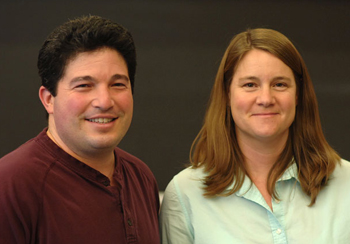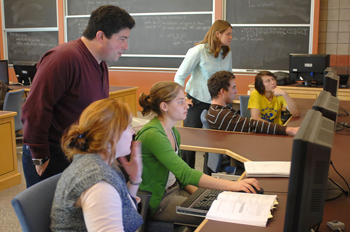BIOL/CMPU 353
 Taught by: Marc Smith and Jodi Schwarz
Taught by: Marc Smith and Jodi Schwarz
The Course
What is the course in which you use instructional technologies about? Tell us about its origin, goals and objectives.
Jodi first conceived of teaching an interdisciplinary course in bioinformatics, and approached Marc about joining her in this effort. Bioinformatics being an interdisciplinary field, we both felt neither of us could teach a better course alone than what we could develop together. We wanted to bring students together from biology and computer science, to learn to speak each other’s language so that they could collaborate with each other on research projects. We didn’t want to try to turn computer scientists into biologists, or vice versa. But if we could give students the experience of participating in the algorithm design process to answer genomic questions, we felt that would be a valuable experience.
The Technology
What were the technologies used and how did they change or enhance your course?
We used the the Sci Vis Lab workstations mainly to access network-based bioinformatics tools, either via web browser or remote login. In addition, the screen sharing capabilities of Sci Vis made it possible to display anyone’s monitor to the big screen, or to everyone else’s monitor throughout the lab. This was really wonderful to have. We saved a lot of time and hassle from avoiding having to transfer files via USB sticks just to display files on the big screen.
We used bionf, a high-performance computing cluster hosted within the Computer Science Department. This cluster has the BioTeam’s iNquiry portal installed, with a suite of bioinformatics tools that can be used via the web or command line. The iNquiry suite of tools was made possible by a Fran Fergusson Technology Grant. The cluster was paid for jointly by the Dean of Faculty’s office and the Biology and Computer Science Departments.
 The Student Response
The Student Response
How have your students responded to your use of this technology?
The students have been absolutely thrilled with our course. From the CEQs, they didn’t want it to end. A group of students have even formed BiTT, the Bioinformatics Think Tank, whose purpose is to work with faculty to develop bioinformatic tools to help assist with their research
Regarding the PC Tablet technology, it was somewhat laborious to pass the laptop around to members of the class, and we are not sure that the class concluded that the pedagogical payoff adequately compensated for the time and effort it took to circulate the laptop to 25 different people. When we controlled the Tablet ourselves, however, and used it to project documents for editing or oral questioning about a text, it worked beautifully.
The Challenges
What were the challenges you faced when teaching this course?
We needed to learn to speak each other’s language, first. Marc and learned so much about biology and genomics, and Jodi has learned a lot about algorithms and data structures.
Enrollments remain a challenge. Hopefully the excitement and word-of-mouth will spread. We believe the challenge is one of student perceptions. CS students are afraid to take bioinformatics for fear they don’t know any biology, and biology students are afraid of the course because they are intimidated by their lack of knowledge of computer programming and computer science. We continue to hone our message that the reason to collaborate is precisely so that people with different expertise can accomplish a goal that neither could alone.
In terms of computational infrastructure, we are fortunate to have Greg Priest-Dorman’s support as sysadmin for bioinf, and Cristian Opazzo’s support in Sci Vis for installation of software on the workstations and screen sharing. There were days the course could have been a disaster without their support.
New Directions
What new directions would you like to explore with technology in your teaching?
Over time, it would be nice to build up the local computational infrastructure on campus, either through supercomputing, or in-house hosting of large databases, or locally developed resources like AiptasiaBase and AiptasiaWiki.
